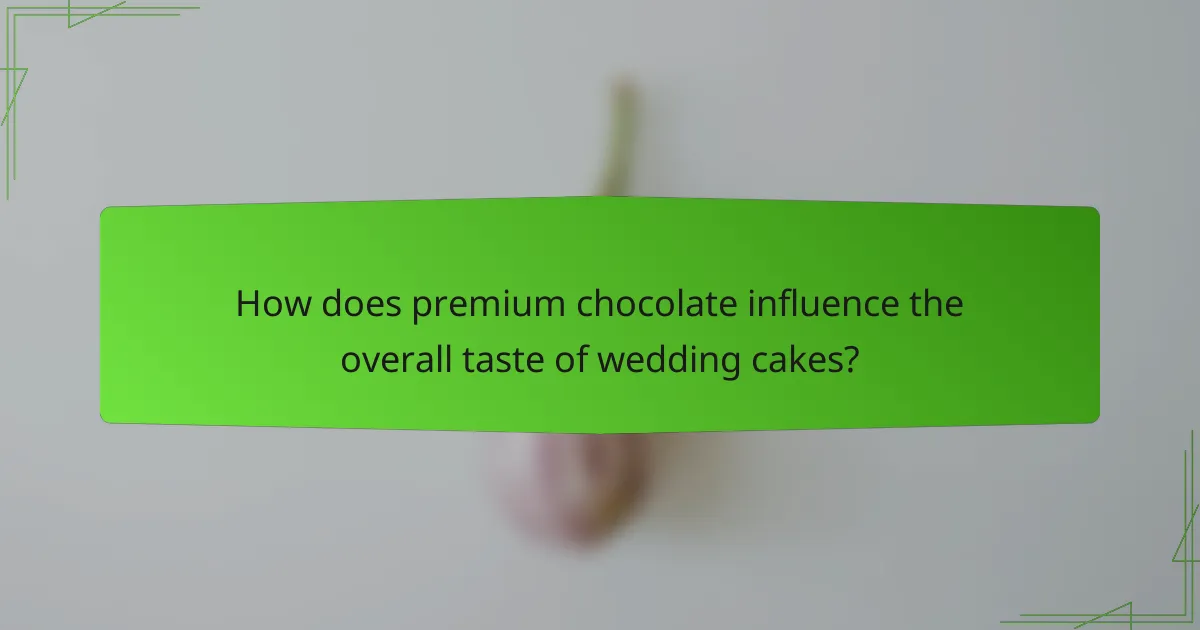
What is Premium Chocolate in Wedding Cakes?
Premium chocolate in wedding cakes refers to high-quality chocolate made from fine cocoa beans. This chocolate is often characterized by its rich flavor and smooth texture. It typically contains a higher percentage of cocoa solids compared to standard chocolate. The sourcing of premium chocolate often involves fair trade practices and sustainable farming methods. Many bakers choose premium chocolate for its superior taste and ability to enhance the overall flavor profile of the cake. It is commonly used in ganaches, fillings, and decorations. The use of premium chocolate can significantly elevate the quality of wedding cakes, making them more luxurious and memorable.
Why is premium chocolate preferred for wedding cakes?
Premium chocolate is preferred for wedding cakes due to its superior taste and quality. This type of chocolate has a higher cocoa content, which results in a richer flavor. The texture of premium chocolate is also smoother, enhancing the overall mouthfeel of the cake. Additionally, premium chocolate often contains fewer additives and preservatives, making it a more natural choice.
Weddings are significant events, and couples want their cakes to reflect that importance. The use of premium chocolate elevates the cake’s status, making it more luxurious. According to a survey by The Knot, 60% of couples consider flavor the most important factor when choosing a wedding cake. Premium chocolate consistently ranks high in taste tests, supporting its popularity among couples.
What distinguishes premium chocolate from regular chocolate?
Premium chocolate is distinguished from regular chocolate by its higher cocoa content and superior ingredient quality. Premium chocolate typically contains at least 70% cocoa solids, which enhances its flavor complexity. In contrast, regular chocolate often has lower cocoa percentages, resulting in a sweeter and less intense taste.
Additionally, premium chocolate uses finer quality cocoa beans, often sourced from specific regions known for unique flavor profiles. The production process for premium chocolate is also more meticulous, often involving bean-to-bar craftsmanship. This care in production leads to a smoother texture and richer taste compared to mass-produced regular chocolate.
Moreover, premium chocolate often avoids artificial additives and preservatives, relying on natural ingredients. This commitment to quality not only elevates the taste but also provides a more authentic chocolate experience.
How does the quality of chocolate impact cake flavor?
The quality of chocolate significantly impacts cake flavor. High-quality chocolate enhances the richness and depth of flavor in cakes. It contains more cocoa solids and cocoa butter, contributing to a more intense chocolate taste. Premium chocolate often has fewer additives, resulting in a cleaner flavor profile. The bitterness and sweetness balance in high-quality chocolate can elevate the overall taste experience. Additionally, the aroma of fine chocolate adds to the sensory appeal of the cake. Studies show that cakes made with higher quality chocolate are generally preferred in taste tests. This preference is linked to the smoother texture and complex flavor notes of premium chocolate.
What types of premium chocolate are commonly used in wedding cakes?
Dark chocolate, milk chocolate, and white chocolate are commonly used in wedding cakes. Dark chocolate is favored for its rich flavor and high cocoa content. Milk chocolate offers a creamier taste and sweetness. White chocolate, made from cocoa butter, provides a smooth and sweet alternative. Many bakers prefer high-quality brands like Valrhona or Guittard for their premium chocolate options. These chocolates enhance the overall taste and texture of the cake. Additionally, they can be used in ganaches, fillings, or decorations. The choice of chocolate can significantly influence the cake’s flavor profile.
What are the different forms of premium chocolate available?
Premium chocolate is available in several forms. These include bars, truffles, ganache, and cocoa powder. Each form offers unique textures and flavors. Chocolate bars can be solid or filled with various ingredients. Truffles are often hand-rolled and coated in cocoa or nuts. Ganache is a smooth mixture of chocolate and cream, used in fillings or toppings. Cocoa powder is used in baking and beverages. These forms cater to diverse culinary applications and preferences.
How does dark chocolate compare to milk and white chocolate in wedding cakes?
Dark chocolate is richer and more intense in flavor compared to milk and white chocolate in wedding cakes. It typically contains a higher percentage of cocoa solids, often above 70%. This results in a more complex taste profile with notes of bitterness and depth. In contrast, milk chocolate is sweeter and creamier due to added milk solids and sugar. White chocolate lacks cocoa solids entirely, relying on cocoa butter for its texture and sweetness.
The choice of chocolate in wedding cakes affects overall flavor and guest preference. Dark chocolate is often favored for its sophisticated taste and pairing with bold flavors like raspberry or espresso. Milk chocolate appeals to those who prefer a sweeter, lighter taste. White chocolate is chosen for its creamy texture and ability to complement fruity or buttery flavors.
Research indicates that dark chocolate has health benefits, including antioxidants and lower sugar content. This can make it a more appealing option for health-conscious couples. In summary, dark chocolate offers a distinct flavor profile, while milk and white chocolate provide sweetness and creaminess, influencing the overall taste of wedding cakes.

How is premium chocolate sourced for wedding cakes?
Premium chocolate for wedding cakes is sourced from high-quality cacao beans. These beans are often sourced from specific regions known for their unique flavor profiles, such as Ecuador or Madagascar. Farmers cultivate these cacao beans under controlled conditions to ensure optimal quality. After harvesting, the beans undergo fermentation and drying processes to enhance their flavor.
Chocolate manufacturers then select the best beans based on taste and aroma. They may conduct taste tests to ensure consistency and quality. The selected beans are roasted to develop their flavor further. Finally, the roasted beans are ground into chocolate liquor, which is then refined and conched to achieve a smooth texture.
This meticulous sourcing and processing ensure that the premium chocolate used in wedding cakes meets high standards for taste and quality.
What factors should be considered when sourcing premium chocolate?
When sourcing premium chocolate, consider the cocoa origin, quality of ingredients, and ethical sourcing practices. The cocoa origin affects flavor profiles and quality. For instance, single-origin chocolates often have unique taste characteristics. The quality of ingredients, such as cocoa solids and butter, impacts texture and richness. Ethical sourcing practices, like fair trade certifications, ensure sustainable production. Additionally, check for certifications like organic or non-GMO. Taste tests can help evaluate flavor and texture. Finally, consider the supplier’s reputation and reliability in delivering consistent quality.
How do ethical sourcing practices influence chocolate quality?
Ethical sourcing practices significantly enhance chocolate quality. These practices ensure that cocoa is sourced from farms that prioritize sustainable agriculture. Sustainable farming methods improve soil health and biodiversity. Healthier soil leads to better cocoa bean quality. Additionally, ethical sourcing often involves fair trade practices. Fair trade ensures farmers receive fair compensation. This financial stability allows farmers to invest in better cultivation techniques. Research shows that ethically sourced chocolate often has richer flavor profiles. A study by the University of California found that sustainably grown cocoa beans have higher levels of desirable flavor compounds. Thus, ethical sourcing directly correlates with superior chocolate quality.
What is the role of chocolate origin in flavor profiles?
Chocolate origin significantly influences its flavor profiles. Different regions produce cocoa beans with unique characteristics. For example, beans from Madagascar often have fruity and floral notes. In contrast, beans from Ecuador may exhibit nutty and earthy flavors. The terroir, or environmental factors, contributes to these distinct flavors. Factors such as soil composition, climate, and cultivation methods play a crucial role. Additionally, the fermentation and drying processes impact the final taste. Research indicates that origin-specific flavor compounds are present in varying concentrations. This diversity enhances the complexity of chocolate in culinary applications, including wedding cakes.
What are the best practices for selecting premium chocolate for wedding cakes?
Select high-quality chocolate with a cocoa content of at least 60%. This ensures rich flavor and proper texture. Look for chocolate labeled as “couverture” for its high cocoa butter content. Couverture chocolate melts smoothly, making it ideal for ganache and coating. Choose chocolate from reputable brands known for sourcing fine cocoa beans. Brands like Valrhona and Callebaut are recognized for their premium quality. Verify the chocolate’s origin, as single-origin chocolates often provide unique flavor profiles. Consider the intended use, whether for baking, molding, or ganache, as different chocolates serve specific purposes. Finally, taste test different chocolates to find the best flavor that complements the cake.
How can bakers ensure they are purchasing high-quality chocolate?
Bakers can ensure they are purchasing high-quality chocolate by sourcing from reputable suppliers. They should look for chocolate with a high cocoa content, ideally above 60%. Checking for certifications such as Fair Trade or organic can indicate quality sourcing practices. Bakers should also examine the ingredient list for minimal additives and fillers. Tasting samples before bulk purchases can help evaluate flavor and texture. High-quality chocolate often has a smooth mouthfeel and rich aroma. Reading reviews and seeking recommendations from other bakers can provide insights into reliable brands. Understanding the origin of the chocolate can also inform quality, as certain regions are known for superior cacao.
What certifications should be looked for when sourcing chocolate?
Look for certifications such as Fair Trade, Rainforest Alliance, and USDA Organic when sourcing chocolate. Fair Trade certification ensures that farmers receive fair compensation and work under safe conditions. Rainforest Alliance certification promotes sustainable farming practices that protect ecosystems. USDA Organic certification guarantees that the chocolate is made from organic ingredients without synthetic pesticides. These certifications help ensure ethical sourcing and quality in chocolate production.

How does premium chocolate influence the overall taste of wedding cakes?
Premium chocolate enhances the overall taste of wedding cakes by providing rich flavor and smooth texture. It adds depth and complexity to the cake’s profile. The quality of premium chocolate often results in a more intense cocoa flavor. This contributes to a luxurious mouthfeel that standard chocolate may lack. Additionally, premium chocolate can balance sweetness in cake recipes. It complements other ingredients like fruits and creams effectively. Studies show that higher cocoa content improves taste satisfaction. Overall, premium chocolate elevates the sensory experience of wedding cakes.
What flavor profiles can premium chocolate add to wedding cakes?
Premium chocolate can add rich, complex flavor profiles to wedding cakes. It enhances sweetness with notes of vanilla and caramel. Dark chocolate introduces bitterness and depth, balancing sweetness. Milk chocolate provides creaminess and smoothness, contributing to a velvety texture. White chocolate adds sweetness and a hint of creaminess without cocoa bitterness. Flavor infusions, such as sea salt or spices, can enhance the chocolate’s characteristics. Premium chocolate’s high cocoa content intensifies these flavors. The quality of chocolate impacts the overall taste experience significantly.
How do different types of chocolate enhance specific cake flavors?
Different types of chocolate enhance specific cake flavors by contributing distinct taste profiles and textures. Dark chocolate adds a rich, intense flavor that pairs well with fruity and nutty cake flavors. Milk chocolate provides a creamy sweetness that complements vanilla and caramel cakes. White chocolate introduces a smooth, buttery taste, enhancing cakes with citrus or floral notes. Each chocolate type also affects the cake’s moisture and richness, influencing the overall mouthfeel. For example, dark chocolate can create a denser cake, while milk chocolate often results in a lighter texture. The choice of chocolate can also impact the cake’s visual appeal, as darker chocolates provide a striking contrast to lighter cake colors.
What are the sensory experiences associated with premium chocolate in cakes?
Premium chocolate in cakes provides rich sensory experiences. The taste is often deep and complex, offering notes of bitterness and sweetness. The texture is smooth and creamy, enhancing the mouthfeel. Aroma plays a significant role, with a strong, enticing scent that can include hints of vanilla or fruit. Visual appeal is also crucial; premium chocolate often has a glossy finish that indicates quality. When melted, it creates a luxurious experience, coating the palate. These sensory elements contribute to the overall enjoyment of cakes made with premium chocolate.
What are some tips for incorporating premium chocolate into wedding cakes?
Incorporating premium chocolate into wedding cakes enhances flavor and texture. Use high-quality chocolate for ganache, frosting, or cake layers. Melt premium chocolate for a smooth ganache, ensuring even distribution. Consider adding chocolate shavings or curls for decoration. Layer chocolate cake with complementary flavors like raspberry or hazelnut. Use chocolate as a filling for added richness. Experiment with different chocolate types, such as dark, milk, or white, for varied taste profiles. Ensure proper storage to maintain chocolate’s quality and prevent bloom.
How can bakers balance chocolate flavors with other cake components?
Bakers can balance chocolate flavors with other cake components by adjusting ingredient ratios and utilizing complementary flavors. They can reduce the amount of chocolate used in the cake batter to allow other flavors to shine. Incorporating vanilla or almond extracts can enhance the overall flavor profile without overpowering the chocolate. Using lighter chocolate varieties, like milk chocolate, can create a milder flavor that blends well with other ingredients. Additionally, bakers can use acidic components, such as fruit purees or citrus zest, to contrast the richness of chocolate. This technique helps to elevate the cake’s flavor complexity. Finally, pairing chocolate with textures, like crunchy nuts or creamy fillings, can create a harmonious balance in both taste and mouthfeel.
What common mistakes should be avoided when using premium chocolate in cakes?
Using premium chocolate in cakes requires careful attention to avoid common mistakes. One mistake is not tempering the chocolate properly. Proper tempering ensures a smooth texture and glossy finish. Another mistake is using chocolate that is not suitable for baking. Baking chocolate should have a higher cocoa content for the best flavor. Additionally, over-melting chocolate can lead to seizing. Seized chocolate becomes grainy and unusable. Not measuring chocolate accurately can also ruin the cake’s balance. Each recipe has specific chocolate requirements. Lastly, neglecting to pair chocolate with complementary flavors can diminish the overall taste. Balancing chocolate with ingredients like vanilla or coffee enhances its richness.
Premium chocolate in wedding cakes is defined as high-quality chocolate made from fine cocoa beans, characterized by its rich flavor and smooth texture. The article explores the types of premium chocolate used, including dark, milk, and white chocolate, and discusses their sourcing, emphasizing ethical practices and the impact of chocolate origin on flavor profiles. Additionally, it examines how the quality of chocolate influences the overall taste of wedding cakes, highlighting best practices for selection and common mistakes to avoid when incorporating premium chocolate into cake recipes.
